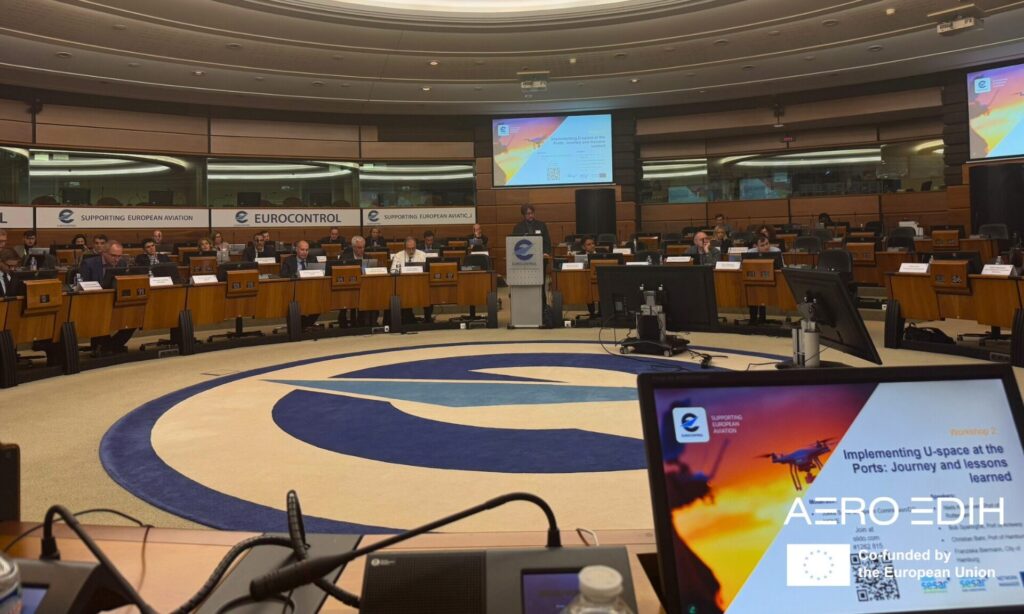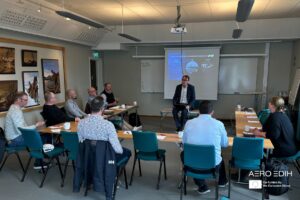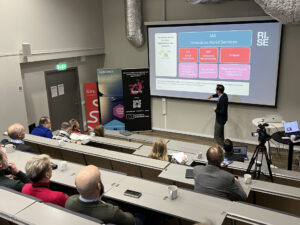Aero EDIH Participated in the European Network of U-Space Stakeholders Meeting in Brussels.
The aim was to share experiences from ongoing U-Space implementation activities across Europe. New key connections and collaborations between Aero EDIH and test sites throughout Europe were established. It was a very interesting and rewarding conference.
In summary, the focus of the day was on leveraging past experiences to encourage and enhance drone operations while ensuring safety and market adaptation. Below, we present a few brief summaries of the topics discussed – Are you gaining any new insights?

Key Insights We Took Away
- Data Needs: The importance of gathering more drone flight data to improve decision-making and airspace risk assessments. Data from the services in various European ports should be helpful here.
- Phased Implementation: Belgium is adopting a phased approach to drone operations, starting with simpler tasks outside controlled airspace and gradually increasing complexity.
- Safety and Economics: Emphasizes the necessity of maintaining high safety standards in drone operations while balancing business interests, asserting that safety should remain the priority.
- Weather Data: Identifies a gap in recognizing the weather data needed by drone operators, highlighting the need for collaborative efforts to address this issue.
- Market Perspective: Suggests that understanding market needs and the requirements of drone operators is critical for future developments.
- Regulatory Changes: Mentions upcoming revisions to regulations and the importance of learning from stakeholders, including ports that are exploring regular drone usage and collecting data.
Weather Panel
Andrew Hately (EIH) as moderator and participants was Don Berchoff (TruWeatherSolutions), Stephane Vauburg (EASA), Christoph Schletting (Unisphere), Fernando Trolia Slamic (VAISALA) and Simon Delvodere (Skeyes).
Overall initial conclusion:
- No need for more detailed weather information (at present), in discussions and network conversations it became clear that operators soon will need higher quality weather information in real-time in order to optimise their operations to reach efficiency KPIs and optimise usage of the drones capability.
- A recent observation from a US drone operator said they had to cancel 40% of missions due to missing weather information, simply to many cancellations. 20% may be acceptable.
- A number of micro weather systems and sensors in collab w NASA, Hampton Virginia.
- SKEYES argued (with support from many nods) Lets start using U space services and feedback to EASA quickly, we cannot wait any longer.
Ongoing Drone Services in European Ports, Antwerpen, Bruges, and Hamburg
- Drone – in – a- box concept seems to be the winning formula.
- Successful implementation in ports largely depending on the following steps:
– Build a multidisciplinary ecosystem
– Involve legal partners from the start
– Don’t underestimate the change management
– Conceive with evolution in thought
– Evolve from “risk mitigation” to “risk control” mindset
– Look beyond “Airspace” and “Business driver” for U-space
GUTMA Task Force’s Global Conclusions
GUTMA Global UTM Association presented a survey the ordered from PwC.
“We came to the conclusions that most of dimensions have their unique regional leaders but the strategic and market-oriented approach requires improvement among all of the regions.”
- Legislation: EU with its U-Space Regulations 2021/664-666 is leading in the regulatory enablement of commercial and scalable BVLOS drone operations, however with a slow progress in the national implementation.
- Governance: Japan is a great example of developed culture of cooperation between public (ministries, CAAs, ANSPs) and private (associations, drone & UTM services companies, etc.) stakeholders.
- Strategy: There is a lack of strategic documents at the organisational and national levels addressing the UTM implementation/low-altitude economy, with existing ones being often outdated.
- Operations: The implementation of drone (geo)zones is often related to the UTM technological advancement. The US is leading in the enablement of commercial and scalable BVLOS airspace implementations.
- Technology: There are mostly basic airspace (geo-)awareness tools implemented, with a limited number of advanced UTM system implementations.
- Business & Market: There is a minor use of tools (market sizing, value chain mapping, pricing strategies, business plans), and thus a low economic understanding of the low-altitude economy. Australia is a notable exception.
- Best Practices: Examples of diversified by geography and use-cases commercial and scalable BVLOS services, with the highlight of best practices.

The Aero EDIH delegation is represented by Martin Holmberg, Rasmus Lundqvist, Jan-Olof Ehk and Billy Josefsson.















